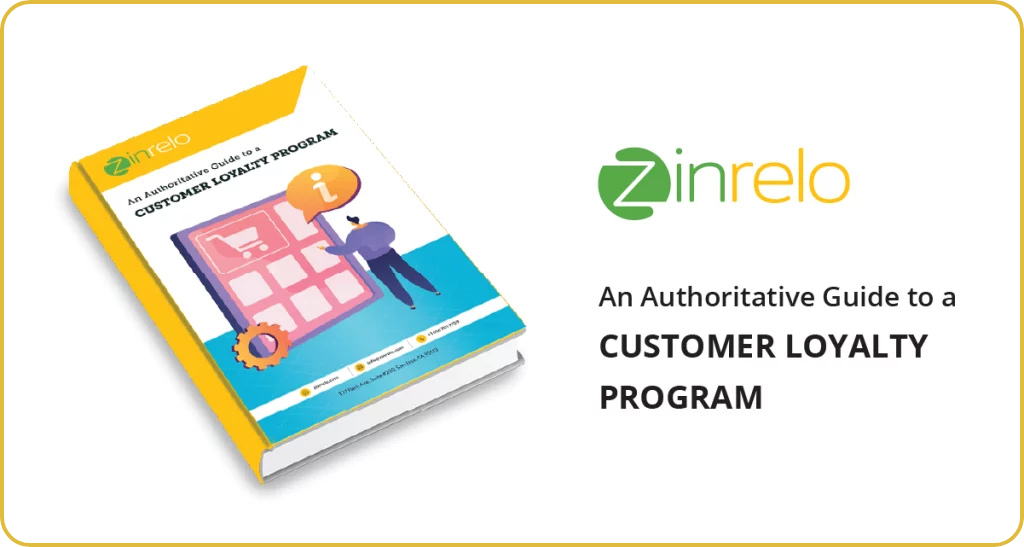
ALL THE BRAND LOYALTY AND CUSTOMER REWARDS PROGRAM STATISTICS YOU NEED TO KNOW
Understanding customer loyalty is paramount for businesses aiming to scale and grow in this evolving market. The customer loyalty statistics and loyalty program statistics given here offer invaluable insights into consumer behavior, preferences, and the factors that foster brand advocacy. Understanding how customer loyalty and engagement affect your business is important, as it helps businesses create strategies that not only attract but also retain customers in a highly competitive market.
The benefit of customer loyalty goes beyond mere transactional interactions; it’s about creating an emotional bond between the brand and the consumer, nurtured through trust, value, and consistent satisfaction. Loyalty program statistics will clearly tell you that such reward programs are more than just a marketing tool; they are a cornerstone in building long-lasting relationships with customers. These statistics provide a comprehensive overview of how loyalty programs influence customer behavior, drive sales, and enhance customer engagement.
On this page, you will find meticulously compiled hundred-plus customer loyalty, customer retention, and revenue growth statistics, offering a 360-degree view of the current trends, effectiveness, and impact of loyalty programs. These statistics are not just numbers; they are insights that can guide businesses in crafting more effective customer retention strategies. Whether you are a startup or an established enterprise, these insights will empower you to design loyalty programs that resonate with your target audience, ensuring your brand remains a preferred choice in a cluttered marketplace.

Top Statistics-Editor’s Choice
In the Editor’s Choice section, we bring you a curated selection of pivotal customer loyalty statistics. These statistics provide a comprehensive overview of the current landscape, highlighting the delicate balance between the costs of acquiring new customers and the benefits of retaining existing ones. This section is particularly insightful for businesses looking to understand the nuances of customer loyalty and its impact on market competition. By examining trends in customer behavior and spending, businesses can better strategize their marketing efforts, focusing on building long-lasting relationships that not only enhance brand loyalty but also contribute to sustainable growth and profitability.
- 57% of consumers spend more on brands to which they are loyal. (Accenture)
- A 5% increase in customer retention correlates with at least a 25% increase in profit. (Bain & Company)
- Customer acquisition cost (CAC) for B2B and B2C companies have risen by almost 50% in the last 5 years. (Profit Well)
- 71% of consumers who are members of loyalty programs say membership is a meaningful part of their relationships with brands. (Bond)
- Merchants lose $29 for every new customer acquired compared to just $9 back in 2013 (businesswire.com)
- Businesses that use personalized marketing, which includes personalized video content, see significant improvements in customer loyalty by 47% and customer satisfaction by 36%. (Qualifo)
- 72% of global customers feel loyalty toward at least one brand or company. (Zendesk)
- 88% of consumers say it takes three or more purchases to build brand loyalty. (Yotpo)
- The loyalty management market is worth $4.43 billion. (Fortune Business Insights)
- The average American consumer belongs to 16.7 customer loyalty programs. (Bond Brand Loyalty)
- 57% of Gen Z Americans are less loyal to brands now than before the COVID-19 pandemic. (McKinsey)
- A significant 44% of consumers today are purpose-driven, choosing products and brands that align with their values, marking them as the largest consumer segment (IBM). (IBM)
- Brands are recognizing the importance of loyalty management, with investments in this area reaching $6.47 billion, and an anticipated growth to $28.65 billion by 2030. This growth reflects a 23.7% annual increase (Fortune Business Insights). (Fortune Business Insights)
- 60% of loyal customers will purchase more frequently from their preferred companies (Hubspot). (Hubspot)
- The impact of loyalty programs is substantial, as 73% of buyers believe loyalty programs should be a way for brands to demonstrate loyalty to their customers. Moreover, members of loyalty programs generate 12-18% more revenue annually than non-members (Kitewheel, Visioncritical)
- The preferences and behaviors of different generations vary, with 74% of millennials considering switching to a different retailer in case of poor customer service, while 86% of Gen Xers and 85% of Baby Boomers would do the same. (Business Wire)

Customer Loyalty and Loyalty Program Statistics
The Customer Loyalty section delves into the essence of what keeps customers returning to a brand. It presents a series of brand loyalty statistics that shed light on the factors influencing customer loyalty, such as quality, service, and emotional connection. This section is invaluable for businesses seeking to understand the core elements that drive customer loyalty. With important loyalty program statistics, it emphasizes the importance of not just meeting but exceeding customer expectations to foster a loyal customer base. By exploring various aspects of customer loyalty, from emotional engagement to reward programs, businesses can gain insights into developing effective strategies that not only attract but also retain customers, thereby ensuring long-term business success and a strong market presence.
- 75% of consumers will favor a brand if there is a loyalty program. (KPMG)
- 43% of customers spend more on brands that they are loyal to. (Fundera)
- Customers with an emotional relationship with a brand have a 306% higher lifetime value. (Motista)
- 60% of loyal customers will purchase more frequently from their preferred companies. (Hubspot)
- 59% of American consumers say that once they’re loyal to a brand, they’re loyal for life. (Acquia)
- 75% of American consumers are more likely to be loyal to brands that understand them on a personal level. (Acquia)
- Price is the top factor keeping customers loyal to their favorite brands. (Zendesk)
- Over half of global consumers believe customer service is “very important” in brand choice and loyalty. (Microsoft)
- 55% of US and UK consumers say they trust brands less than they did in the past. (Hubspot)
- 65% of a company’s revenue comes from the repeat business of existing customers. (Queue-it)
- It’s 5-25x more expensive to acquire a new customer than to keep an existing one.
- 77% of consumers say they’ve remained loyal to a specific brand for 10 years or more.
- You have a 60-70% chance of selling to an existing customer, versus a 5-20% chance of selling to a new prospect.
- 57% of consumers spend more on brands or providers to which they are loyal.
- A 5% increase in customer retention correlates with a 25% increase in profit.
- Members of loyalty programs generate 12-18% more incremental revenue growth per year than non-members.
- The top performing loyalty programs boost revenue from customers who use them by 15-25% annually.
- Over 83% of consumers say belonging to a loyalty program influences their decision to buy again from a brand.
- 84% of consumers say they’re more likely to stick with a brand that offers a loyalty program.
The Only Loyalty Program Guide You Will Ever Need!
Dive into Zinrelo’s in-depth free customer loyalty program guide to learn everything you need before building a modern-day loyalty program for your business.


Customer Engagement Statistics
Customer engagement is a critical driver of brand loyalty, as this section vividly illustrates through various loyalty program statistics. It delves into how personalized and strategic engagement efforts can significantly boost customer loyalty, transforming casual buyers into loyal brand advocates. This segment is particularly valuable for businesses seeking to understand the dynamics of customer interaction and its direct impact on loyalty. By exploring different engagement strategies, from personalized marketing to tailored customer experiences, businesses can identify effective methods to not only attract but also retain customers, thereby fostering a loyal customer base that is key to long-term success.
- If your business is not doing enough to engage your customers, 54% will consider dropping you. (Fundera)
- 82% of customers feel more positive about a brand after engaging with personalized content. (Demand metric)
- About 80% of businesses still rely on email marketing to assist with maintaining their client retention rate. (Emarsys)
- Customers engaged in a brand’s loyalty program will spend 12-18% more each year. (Fundera)
- 66% of Loyalty program members modify the amount they spend in order to maximize points. (Paystone)
- 31% of American consumers would switch brands if they caught their favorite company lying about product performance or efficiency. (YouGov)
- 36% of American consumers switched brands during the COVID-19 pandemic. (McKinsey)
- 73% of US consumers who switched brands intend on staying loyal to their new brand. (McKinsey)
- 69% of brand executives say they’ve increased loyalty investment over the past two years. (Business Wire)
- 50% of marketers list brand loyalty as one of the top goals of their content marketing strategies. (Digital Information World)

Customer Retention Statistics
This section offers an in-depth analysis of customer retention, emphasizing its importance over acquiring new customers. Through a series of loyalty program stats, it highlights the cost-effectiveness and increased profitability associated with retaining existing customers. For businesses, this section is a treasure trove of insights, demonstrating how focusing on customer retention can lead to sustainable revenue growth. It underscores the need for businesses to invest in customer relationship management and loyalty programs that encourage repeat business, thereby reducing churn rates and enhancing overall customer satisfaction and loyalty.
- 82% of business leaders agree that customer retention is way cheaper compared to customer acquisition. (eConsultancy)
- 30% – that is how high the customer churn rate can be in some global markets. (Deloitte)
- Your chances of selling to a new customer are just between 5% and 20%, whereas that chance rises to 60% or 70% for existing customers. (Forbes)
- Businesses in the US lose $136.8 billion annually due to poor customer retention. (Call Miner)
- Across all verticals, 75% of loyalty members are brand loyalists and won’t switch. Engaged members are the least expensive and most profitable (Think Impact)
- Loyalty management makes up 23% of global brands’ customer ecosystem spending. (Business Wire)
- Brands spend over $75 billion per year on loyalty management alone. (Business Wire)
- Attracting new customers is the top goal for brands investing in customer loyalty strategies. (Harvard Business Review)
- Mobile solutions are the leading customer loyalty tech investment for global brands. (Harvard Business Review)
- Just 2 in 5 brand executives think their customer loyalty strategies are effective. (Harvard Business Review)

Customer Experience
The Customer Experience section links the quality of customer interactions directly to brand loyalty. It uses a range of brand loyalty statistics to demonstrate how a positive customer experience is crucial in building loyalty. This section is essential for businesses aiming to understand the impact of customer experience on loyalty and retention. It suggests that by focusing on delivering personalized and satisfying experiences, businesses can significantly increase customer loyalty. This approach not only helps in retaining customers but also turns them into brand ambassadors, thereby amplifying the brand’s reach and reputation in the market.
- About 50% of loyal customers have left a company for a competitor who was able to stay more relevant and better satisfy their needs. (InMoment)
- 93% of customers are likely to make repeat purchases with companies who offer excellent customer service. (Hubspot Research)
- 62% of consumers are willing to spend more if their shopping experience is customized to their interests. (Business Wire)
- 75% of US consumers have changed their shopping habits. The reasons cited were availability, price, and convenience. (McKinsey)
- 53% of customers stating getting good value was the top reason people patronize a business. 30% stated they liked the benefits, rewards, and privileges of “a preferred company’s loyalty program.” (PwC)
- Customers are 8x as likely to be satisfied with a loyalty program if it feels personalized to them. (Forbes)
- Customers, around 72%, would switch to a brand’s competitor after a negative customer service experience. (Hiver Research Report)
- Taking too long to earn rewards is the most common reason consumers dislike a loyalty program. (Loyalty Magazine)
- 64% of loyalty program members spend more money to maximize points earnings. (Bond Brand Loyalty)
- 59% of paid loyalty members are more likely to choose that brand over competitors. (McKinsey)
- 60% of consumers spend more on a brand if they have a paid loyalty membership. (McKinsey)
- 58% of American shoppers expect free shipping and no order minimums with their paid loyalty memberships. (Statista)

Business Revenue Statistics
In the Revenue section, the focus is on how customer loyalty translates into increased business revenue. It presents a series of loyalty program stats that demonstrate the financial benefits of a loyal customer base. This section is particularly useful for businesses looking to understand the direct correlation between customer loyalty and revenue growth. It highlights the importance of investing in loyalty programs and customer retention strategies as a means to boost revenue. By nurturing loyal customer relationships, businesses can ensure a steady stream of revenue, which is crucial for long-term financial stability and growth.
- 80% of your company’s future revenue will come from just 20% of your existing customers. (Gartner)
- Loyalty leaders grow revenues roughly 2.5x as fast as other companies in their industries. (HBR)
- After implementing a loyalty program, the average order quantity a business receives can go up by 319%. (Incentive Solutions)
- Loyalty schemes can help increase revenues: 50% of consumers changed their buying behaviors to reach a higher tier. (Invesp)
- The loyalty management market could be worth as much as $28.65 billion by 2030. (Fortune Business Insights)
- Ecommerce companies are now more focused on retention than conversion or acquisition. (Yieldify)
- 74% of eCommerce brands report boosting efforts to personalize their websites. (Yieldify)
- 45% of consumers don’t appreciate how long it takes to earn rewards from their loyalty programs. (Loyalty Magazine)
- On average, American consumers belong to 16.7 customer loyalty programs. (Bond Brand Loyalty)

Brand Advocacy Statistics
The Advocacy section explores the role of customer advocacy in enhancing brand loyalty. It presents statistics showing how loyal customers can become vocal proponents of a brand. This section is crucial for businesses seeking to leverage customer advocacy as a strategic asset. It illustrates the power of emotional engagement and effective loyalty programs in transforming customers into brand advocates. By fostering strong emotional connections, businesses can encourage customers to actively promote the brand, leading to increased brand visibility, trust, and ultimately, a stronger customer base.
74% of Gen Z shoppers say they’d pay more for apparel products that were environmentally or socially minded. (Statista)
Over 70% of consumers are more likely to recommend a brand if it has a good loyalty program. (Bond)
Emotional engaged customers will recommend the company at a rate of 71%, rather than the average rate of 45%. (Motista)
81% of customers trust recommendations from family and friends over those from companies. (Hubspot research)
Happy American customers will share their positive experiences with and refer about 11 people. (American Express)
American women are 15% more likely to join a loyalty or rewards program than American men. (eMarketer)
71% of millennials say they’d leave good reviews for their favorite brands. (KPMG)
Over half of millennials say they’d abandon a brand’s loyalty program if the rewards weren’t compelling or relevant enough. (Statista)
Millennials are 14 times more likely to access loyalty programs via smartphone than they are from a computer. (Statista)